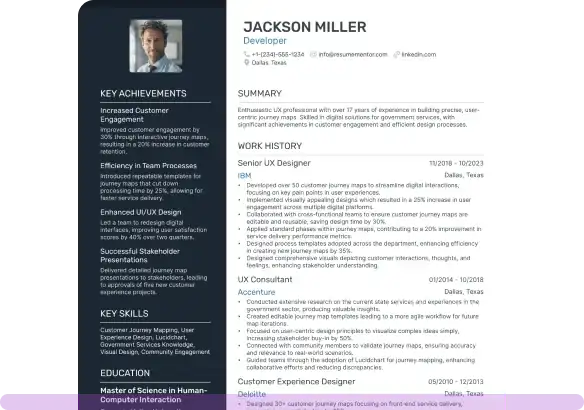Optometrist Resume Examples

Mar 17, 2025
|
12 min read
Ensure your optometrist resume is clearly focused with this guide. You'll gain insights into showcasing your skills and experiences to help you see eye-to-eye with potential employers. Let your qualifications shine clearly.
Rated by 348 people
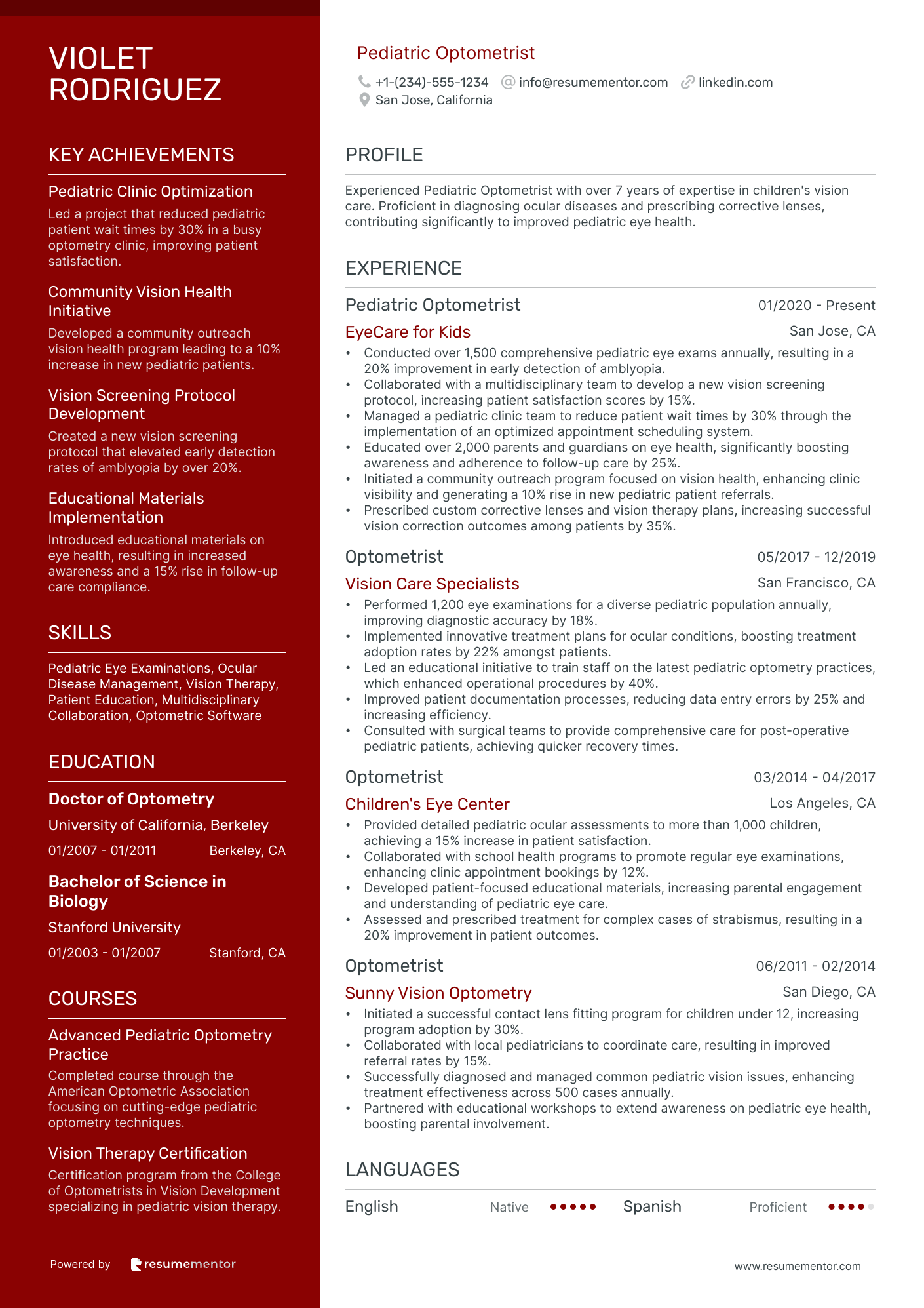
Pediatric Optometrist
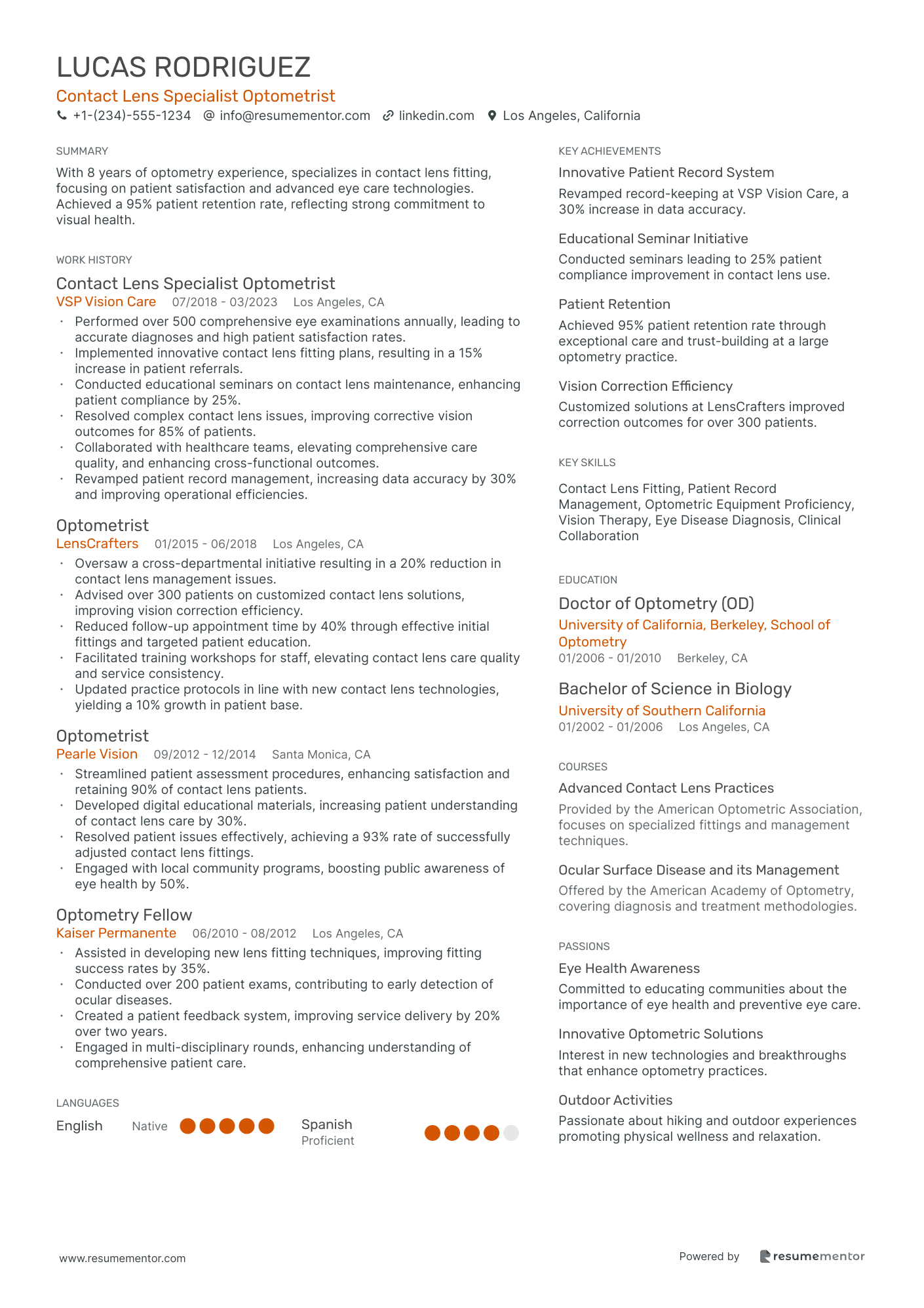
Contact Lens Specialist Optometrist
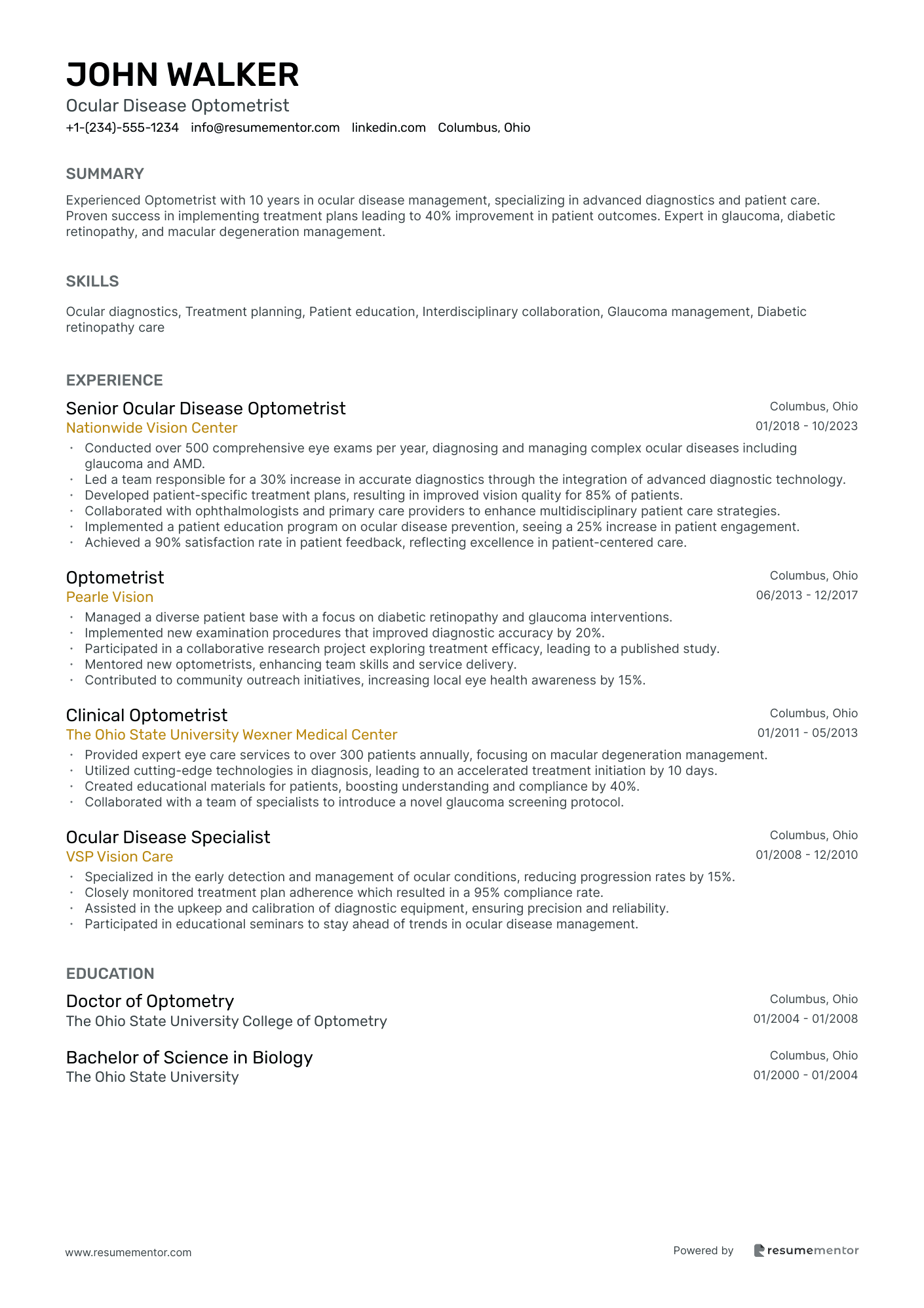
Ocular Disease Optometrist
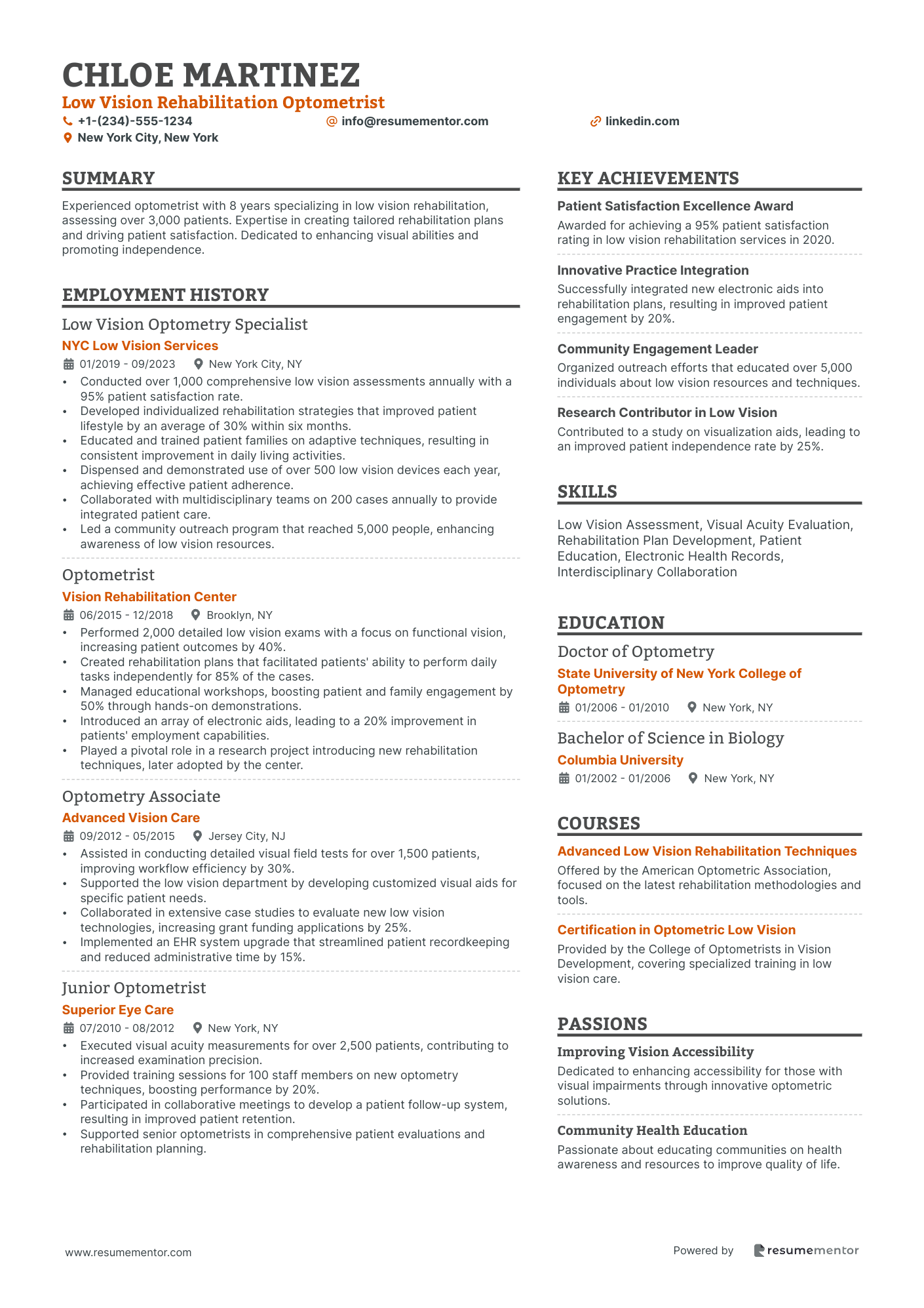
Low Vision Rehabilitation Optometrist

Sports Vision Optometrist
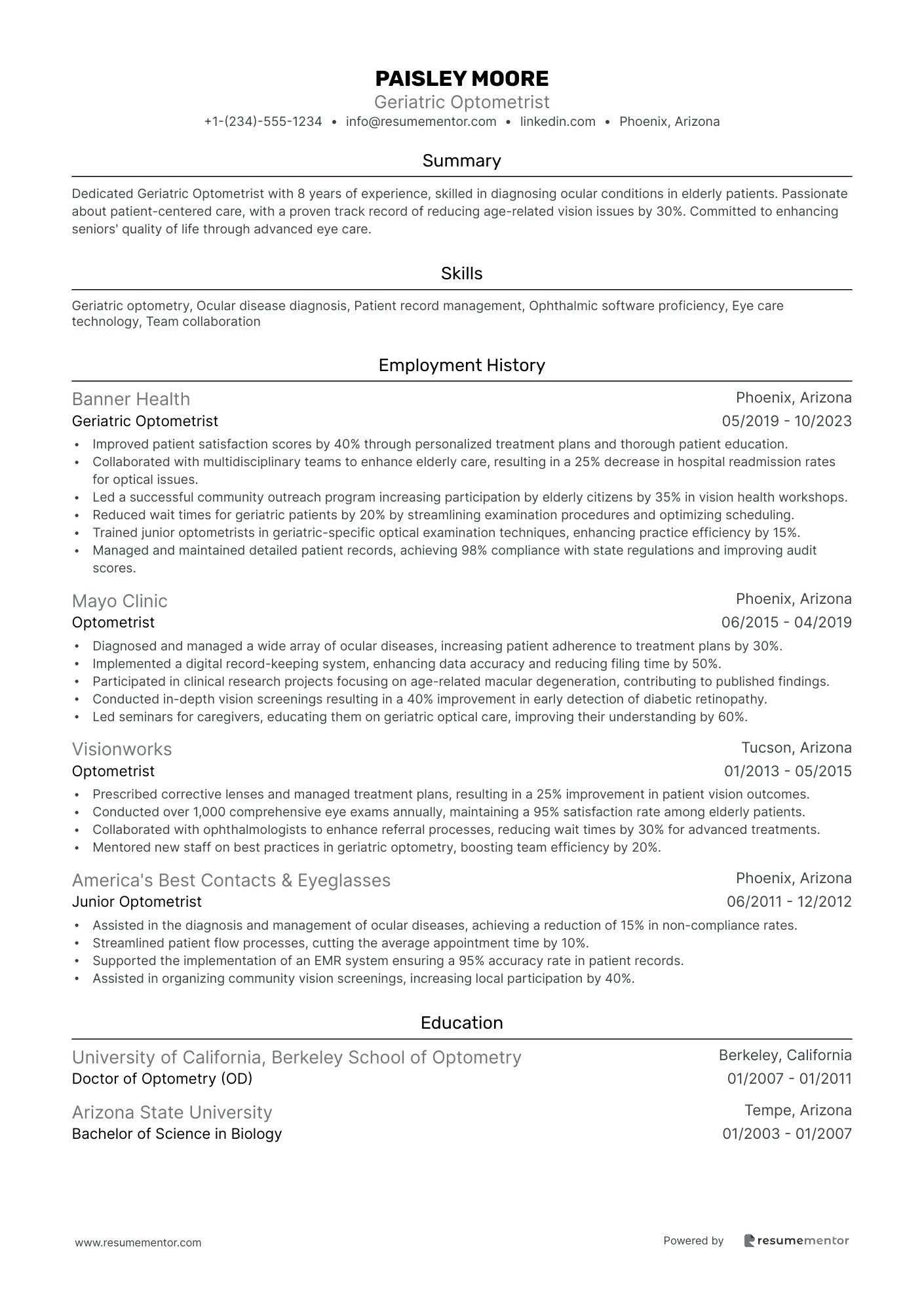
Geriatric Optometrist
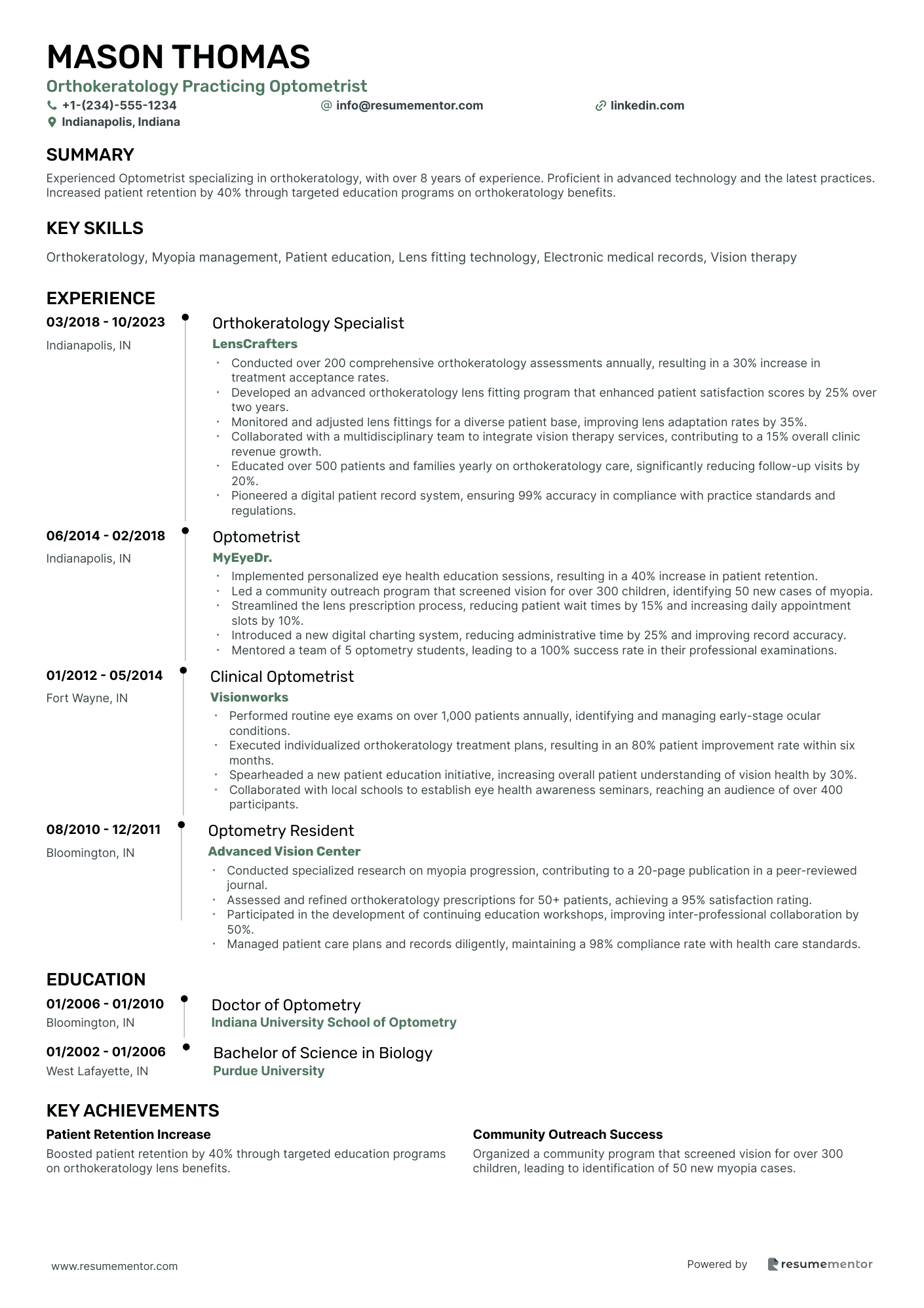
Orthokeratology Practicing Optometrist
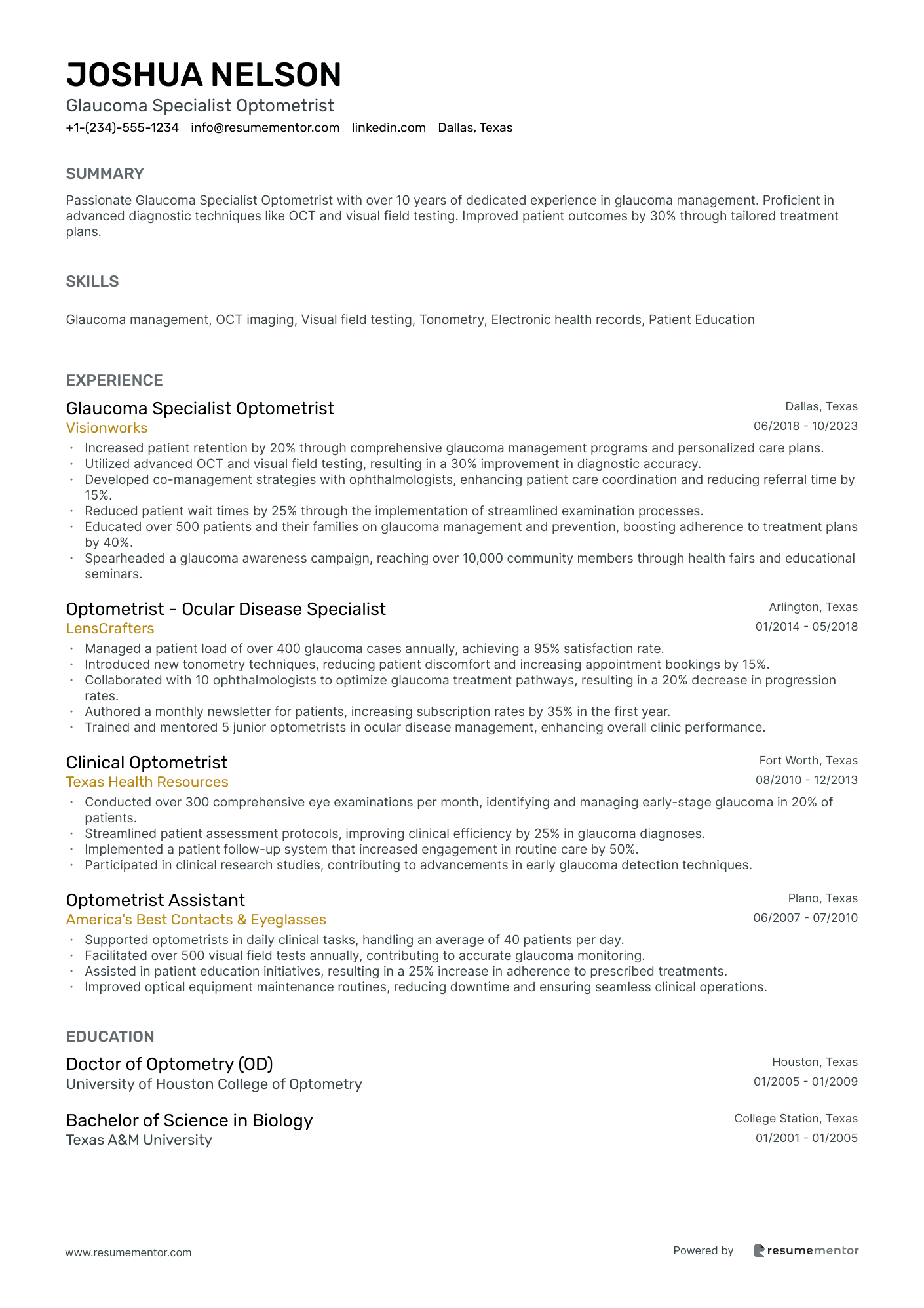
Glaucoma Specialist Optometrist
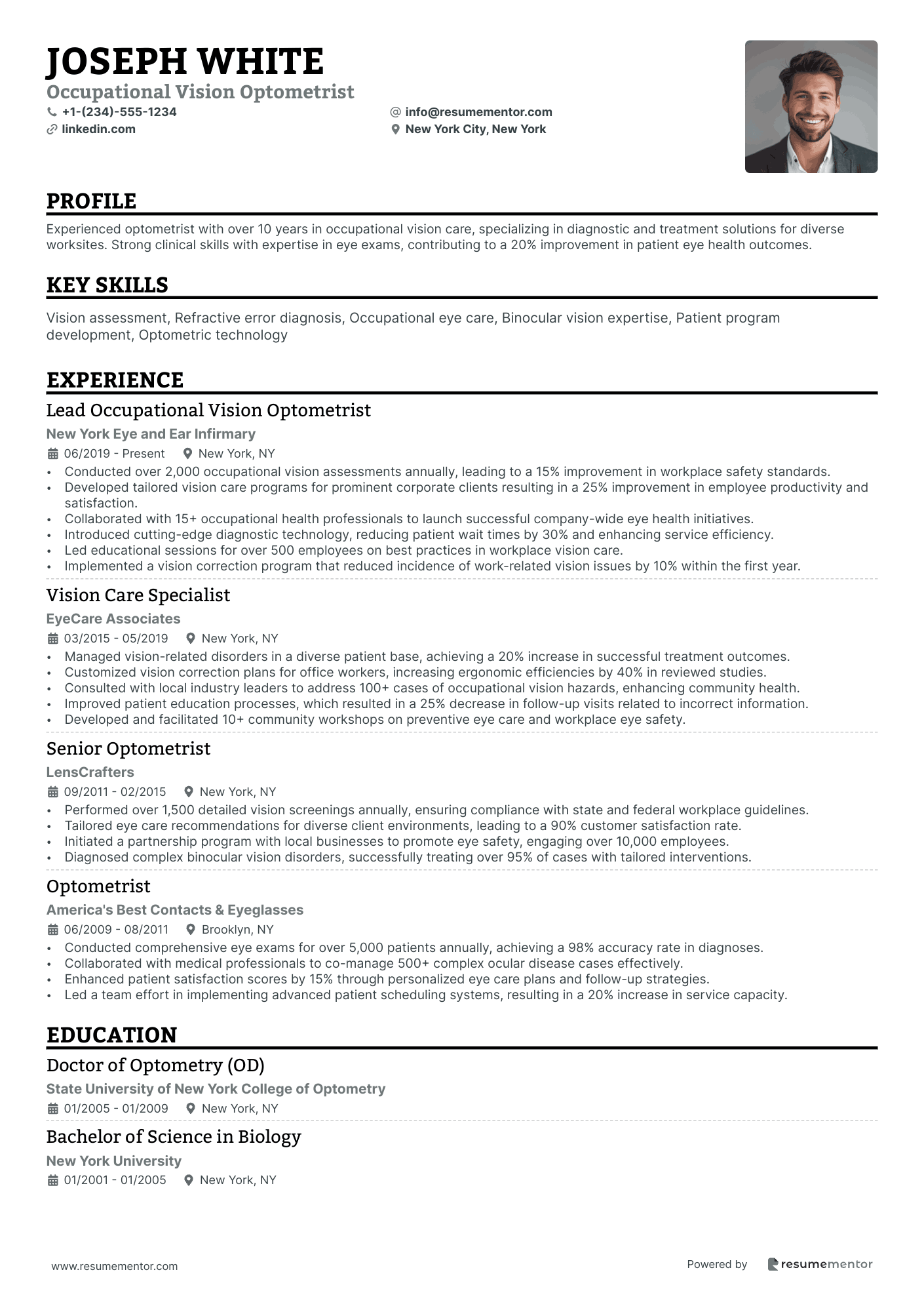
Occupational Vision Optometrist
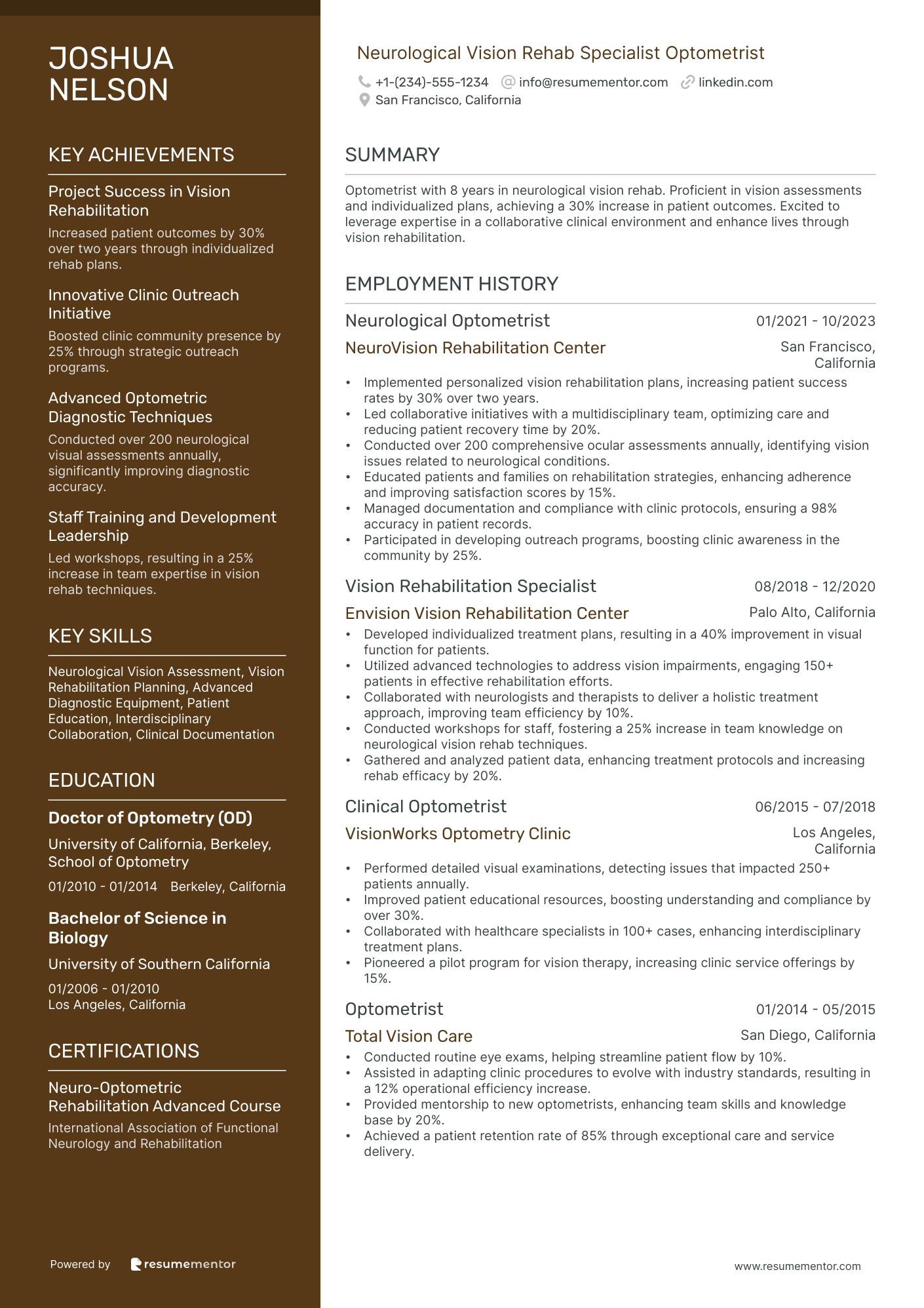
Neurological Vision Rehab Specialist Optometrist

Pediatric Optometrist resume sample
- •Conducted over 1,500 comprehensive pediatric eye exams annually, resulting in a 20% improvement in early detection of amblyopia.
- •Collaborated with a multidisciplinary team to develop a new vision screening protocol, increasing patient satisfaction scores by 15%.
- •Managed a pediatric clinic team to reduce patient wait times by 30% through the implementation of an optimized appointment scheduling system.
- •Educated over 2,000 parents and guardians on eye health, significantly boosting awareness and adherence to follow-up care by 25%.
- •Initiated a community outreach program focused on vision health, enhancing clinic visibility and generating a 10% rise in new pediatric patient referrals.
- •Prescribed custom corrective lenses and vision therapy plans, increasing successful vision correction outcomes among patients by 35%.
- •Performed 1,200 eye examinations for a diverse pediatric population annually, improving diagnostic accuracy by 18%.
- •Implemented innovative treatment plans for ocular conditions, boosting treatment adoption rates by 22% amongst patients.
- •Led an educational initiative to train staff on the latest pediatric optometry practices, which enhanced operational procedures by 40%.
- •Improved patient documentation processes, reducing data entry errors by 25% and increasing efficiency.
- •Consulted with surgical teams to provide comprehensive care for post-operative pediatric patients, achieving quicker recovery times.
- •Provided detailed pediatric ocular assessments to more than 1,000 children, achieving a 15% increase in patient satisfaction.
- •Collaborated with school health programs to promote regular eye examinations, enhancing clinic appointment bookings by 12%.
- •Developed patient-focused educational materials, increasing parental engagement and understanding of pediatric eye care.
- •Assessed and prescribed treatment for complex cases of strabismus, resulting in a 20% improvement in patient outcomes.
- •Initiated a successful contact lens fitting program for children under 12, increasing program adoption by 30%.
- •Collaborated with local pediatricians to coordinate care, resulting in improved referral rates by 15%.
- •Successfully diagnosed and managed common pediatric vision issues, enhancing treatment effectiveness across 500 cases annually.
- •Partnered with educational workshops to extend awareness on pediatric eye health, boosting parental involvement.
Contact Lens Specialist Optometrist resume sample
- •Performed over 500 comprehensive eye examinations annually, leading to accurate diagnoses and high patient satisfaction rates.
- •Implemented innovative contact lens fitting plans, resulting in a 15% increase in patient referrals.
- •Conducted educational seminars on contact lens maintenance, enhancing patient compliance by 25%.
- •Resolved complex contact lens issues, improving corrective vision outcomes for 85% of patients.
- •Collaborated with healthcare teams, elevating comprehensive care quality, and enhancing cross-functional outcomes.
- •Revamped patient record management, increasing data accuracy by 30% and improving operational efficiencies.
- •Oversaw a cross-departmental initiative resulting in a 20% reduction in contact lens management issues.
- •Advised over 300 patients on customized contact lens solutions, improving vision correction efficiency.
- •Reduced follow-up appointment time by 40% through effective initial fittings and targeted patient education.
- •Facilitated training workshops for staff, elevating contact lens care quality and service consistency.
- •Updated practice protocols in line with new contact lens technologies, yielding a 10% growth in patient base.
- •Streamlined patient assessment procedures, enhancing satisfaction and retaining 90% of contact lens patients.
- •Developed digital educational materials, increasing patient understanding of contact lens care by 30%.
- •Resolved patient issues effectively, achieving a 93% rate of successfully adjusted contact lens fittings.
- •Engaged with local community programs, boosting public awareness of eye health by 50%.
- •Assisted in developing new lens fitting techniques, improving fitting success rates by 35%.
- •Conducted over 200 patient exams, contributing to early detection of ocular diseases.
- •Created a patient feedback system, improving service delivery by 20% over two years.
- •Engaged in multi-disciplinary rounds, enhancing understanding of comprehensive patient care.
Ocular Disease Optometrist resume sample
- •Conducted over 500 comprehensive eye exams per year, diagnosing and managing complex ocular diseases including glaucoma and AMD.
- •Led a team responsible for a 30% increase in accurate diagnostics through the integration of advanced diagnostic technology.
- •Developed patient-specific treatment plans, resulting in improved vision quality for 85% of patients.
- •Collaborated with ophthalmologists and primary care providers to enhance multidisciplinary patient care strategies.
- •Implemented a patient education program on ocular disease prevention, seeing a 25% increase in patient engagement.
- •Achieved a 90% satisfaction rate in patient feedback, reflecting excellence in patient-centered care.
- •Managed a diverse patient base with a focus on diabetic retinopathy and glaucoma interventions.
- •Implemented new examination procedures that improved diagnostic accuracy by 20%.
- •Participated in a collaborative research project exploring treatment efficacy, leading to a published study.
- •Mentored new optometrists, enhancing team skills and service delivery.
- •Contributed to community outreach initiatives, increasing local eye health awareness by 15%.
- •Provided expert eye care services to over 300 patients annually, focusing on macular degeneration management.
- •Utilized cutting-edge technologies in diagnosis, leading to an accelerated treatment initiation by 10 days.
- •Created educational materials for patients, boosting understanding and compliance by 40%.
- •Collaborated with a team of specialists to introduce a novel glaucoma screening protocol.
- •Specialized in the early detection and management of ocular conditions, reducing progression rates by 15%.
- •Closely monitored treatment plan adherence which resulted in a 95% compliance rate.
- •Assisted in the upkeep and calibration of diagnostic equipment, ensuring precision and reliability.
- •Participated in educational seminars to stay ahead of trends in ocular disease management.
Low Vision Rehabilitation Optometrist resume sample
- •Conducted over 1,000 comprehensive low vision assessments annually with a 95% patient satisfaction rate.
- •Developed individualized rehabilitation strategies that improved patient lifestyle by an average of 30% within six months.
- •Educated and trained patient families on adaptive techniques, resulting in consistent improvement in daily living activities.
- •Dispensed and demonstrated use of over 500 low vision devices each year, achieving effective patient adherence.
- •Collaborated with multidisciplinary teams on 200 cases annually to provide integrated patient care.
- •Led a community outreach program that reached 5,000 people, enhancing awareness of low vision resources.
- •Performed 2,000 detailed low vision exams with a focus on functional vision, increasing patient outcomes by 40%.
- •Created rehabilitation plans that facilitated patients' ability to perform daily tasks independently for 85% of the cases.
- •Managed educational workshops, boosting patient and family engagement by 50% through hands-on demonstrations.
- •Introduced an array of electronic aids, leading to a 20% improvement in patients' employment capabilities.
- •Played a pivotal role in a research project introducing new rehabilitation techniques, later adopted by the center.
- •Assisted in conducting detailed visual field tests for over 1,500 patients, improving workflow efficiency by 30%.
- •Supported the low vision department by developing customized visual aids for specific patient needs.
- •Collaborated in extensive case studies to evaluate new low vision technologies, increasing grant funding applications by 25%.
- •Implemented an EHR system upgrade that streamlined patient recordkeeping and reduced administrative time by 15%.
- •Executed visual acuity measurements for over 2,500 patients, contributing to increased examination precision.
- •Provided training sessions for 100 staff members on new optometry techniques, boosting performance by 20%.
- •Participated in collaborative meetings to develop a patient follow-up system, resulting in improved patient retention.
- •Supported senior optometrists in comprehensive patient evaluations and rehabilitation planning.
Sports Vision Optometrist resume sample
- •Conducted over 500 sports-focused eye examinations yearly, boosting visual accuracy by 20% for athletes.
- •Developed personalized vision training regimens for athletes, leading to a 25% overall performance enhancement.
- •Liaised closely with coaches, providing eyewear solutions for optimal visual performance during competitions.
- •Led workshops on sports vision, educating 200+ athletes about ocular health and performance.
- •Implemented cutting-edge technology, enhancing depth perception testing accuracy by 30%.
- •Maintained detailed records for 1,000+ patients, ensuring compliance with all regulatory standards.
- •Developed sports vision workshops attended by 150 athletes, promoting eye health and performance.
- •Custom-designed 300+ visual training programs, enhancing sports performance metrics by 18%.
- •Collaborated with 10 sports teams, integrating vision strategies into training sessions.
- •Trained staff in state-of-the-art sports vision techniques, enhancing clinic service quality.
- •Monitored sports vision advancements, adopting tools which increased visual test efficacy by 25%.
- •Performed comprehensive eye exams, improving visual screening results by 15% via innovative techniques.
- •Collaborated on product trials, resulting in a 10% increase in corrective lens effectiveness.
- •Boosted customer satisfaction by 22% through personalized eyewear consultations and fitting sessions.
- •Introduced digital testing tools, reducing examination times by up to 30%.
- •Conducted eye exams leading to an 18% increase in accurate diagnoses.
- •Provided visual performance insights for sports enthusiasts, enhancing focus by 12%.
- •Implemented patient feedback systems, improving service protocols by 20% overall.
- •Contributed to task force that improved eyewear selection efficiency by 15%.
Geriatric Optometrist resume sample
- •Improved patient satisfaction scores by 40% through personalized treatment plans and thorough patient education.
- •Collaborated with multidisciplinary teams to enhance elderly care, resulting in a 25% decrease in hospital readmission rates for optical issues.
- •Led a successful community outreach program increasing participation by elderly citizens by 35% in vision health workshops.
- •Reduced wait times for geriatric patients by 20% by streamlining examination procedures and optimizing scheduling.
- •Trained junior optometrists in geriatric-specific optical examination techniques, enhancing practice efficiency by 15%.
- •Managed and maintained detailed patient records, achieving 98% compliance with state regulations and improving audit scores.
- •Diagnosed and managed a wide array of ocular diseases, increasing patient adherence to treatment plans by 30%.
- •Implemented a digital record-keeping system, enhancing data accuracy and reducing filing time by 50%.
- •Participated in clinical research projects focusing on age-related macular degeneration, contributing to published findings.
- •Conducted in-depth vision screenings resulting in a 40% improvement in early detection of diabetic retinopathy.
- •Led seminars for caregivers, educating them on geriatric optical care, improving their understanding by 60%.
- •Prescribed corrective lenses and managed treatment plans, resulting in a 25% improvement in patient vision outcomes.
- •Conducted over 1,000 comprehensive eye exams annually, maintaining a 95% satisfaction rate among elderly patients.
- •Collaborated with ophthalmologists to enhance referral processes, reducing wait times by 30% for advanced treatments.
- •Mentored new staff on best practices in geriatric optometry, boosting team efficiency by 20%.
- •Assisted in the diagnosis and management of ocular diseases, achieving a reduction of 15% in non-compliance rates.
- •Streamlined patient flow processes, cutting the average appointment time by 10%.
- •Supported the implementation of an EMR system ensuring a 95% accuracy rate in patient records.
- •Assisted in organizing community vision screenings, increasing local participation by 40%.
Orthokeratology Practicing Optometrist resume sample
- •Conducted over 200 comprehensive orthokeratology assessments annually, resulting in a 30% increase in treatment acceptance rates.
- •Developed an advanced orthokeratology lens fitting program that enhanced patient satisfaction scores by 25% over two years.
- •Monitored and adjusted lens fittings for a diverse patient base, improving lens adaptation rates by 35%.
- •Collaborated with a multidisciplinary team to integrate vision therapy services, contributing to a 15% overall clinic revenue growth.
- •Educated over 500 patients and families yearly on orthokeratology care, significantly reducing follow-up visits by 20%.
- •Pioneered a digital patient record system, ensuring 99% accuracy in compliance with practice standards and regulations.
- •Implemented personalized eye health education sessions, resulting in a 40% increase in patient retention.
- •Led a community outreach program that screened vision for over 300 children, identifying 50 new cases of myopia.
- •Streamlined the lens prescription process, reducing patient wait times by 15% and increasing daily appointment slots by 10%.
- •Introduced a new digital charting system, reducing administrative time by 25% and improving record accuracy.
- •Mentored a team of 5 optometry students, leading to a 100% success rate in their professional examinations.
- •Performed routine eye exams on over 1,000 patients annually, identifying and managing early-stage ocular conditions.
- •Executed individualized orthokeratology treatment plans, resulting in an 80% patient improvement rate within six months.
- •Spearheaded a new patient education initiative, increasing overall patient understanding of vision health by 30%.
- •Collaborated with local schools to establish eye health awareness seminars, reaching an audience of over 400 participants.
- •Conducted specialized research on myopia progression, contributing to a 20-page publication in a peer-reviewed journal.
- •Assessed and refined orthokeratology prescriptions for 50+ patients, achieving a 95% satisfaction rating.
- •Participated in the development of continuing education workshops, improving inter-professional collaboration by 50%.
- •Managed patient care plans and records diligently, maintaining a 98% compliance rate with health care standards.
Glaucoma Specialist Optometrist resume sample
- •Increased patient retention by 20% through comprehensive glaucoma management programs and personalized care plans.
- •Utilized advanced OCT and visual field testing, resulting in a 30% improvement in diagnostic accuracy.
- •Developed co-management strategies with ophthalmologists, enhancing patient care coordination and reducing referral time by 15%.
- •Reduced patient wait times by 25% through the implementation of streamlined examination processes.
- •Educated over 500 patients and their families on glaucoma management and prevention, boosting adherence to treatment plans by 40%.
- •Spearheaded a glaucoma awareness campaign, reaching over 10,000 community members through health fairs and educational seminars.
- •Managed a patient load of over 400 glaucoma cases annually, achieving a 95% satisfaction rate.
- •Introduced new tonometry techniques, reducing patient discomfort and increasing appointment bookings by 15%.
- •Collaborated with 10 ophthalmologists to optimize glaucoma treatment pathways, resulting in a 20% decrease in progression rates.
- •Authored a monthly newsletter for patients, increasing subscription rates by 35% in the first year.
- •Trained and mentored 5 junior optometrists in ocular disease management, enhancing overall clinic performance.
- •Conducted over 300 comprehensive eye examinations per month, identifying and managing early-stage glaucoma in 20% of patients.
- •Streamlined patient assessment protocols, improving clinical efficiency by 25% in glaucoma diagnoses.
- •Implemented a patient follow-up system that increased engagement in routine care by 50%.
- •Participated in clinical research studies, contributing to advancements in early glaucoma detection techniques.
- •Supported optometrists in daily clinical tasks, handling an average of 40 patients per day.
- •Facilitated over 500 visual field tests annually, contributing to accurate glaucoma monitoring.
- •Assisted in patient education initiatives, resulting in a 25% increase in adherence to prescribed treatments.
- •Improved optical equipment maintenance routines, reducing downtime and ensuring seamless clinical operations.
Occupational Vision Optometrist resume sample
- •Conducted over 2,000 occupational vision assessments annually, leading to a 15% improvement in workplace safety standards.
- •Developed tailored vision care programs for prominent corporate clients resulting in a 25% improvement in employee productivity and satisfaction.
- •Collaborated with 15+ occupational health professionals to launch successful company-wide eye health initiatives.
- •Introduced cutting-edge diagnostic technology, reducing patient wait times by 30% and enhancing service efficiency.
- •Led educational sessions for over 500 employees on best practices in workplace vision care.
- •Implemented a vision correction program that reduced incidence of work-related vision issues by 10% within the first year.
- •Managed vision-related disorders in a diverse patient base, achieving a 20% increase in successful treatment outcomes.
- •Customized vision correction plans for office workers, increasing ergonomic efficiencies by 40% in reviewed studies.
- •Consulted with local industry leaders to address 100+ cases of occupational vision hazards, enhancing community health.
- •Improved patient education processes, which resulted in a 25% decrease in follow-up visits related to incorrect information.
- •Developed and facilitated 10+ community workshops on preventive eye care and workplace eye safety.
- •Performed over 1,500 detailed vision screenings annually, ensuring compliance with state and federal workplace guidelines.
- •Tailored eye care recommendations for diverse client environments, leading to a 90% customer satisfaction rate.
- •Initiated a partnership program with local businesses to promote eye safety, engaging over 10,000 employees.
- •Diagnosed complex binocular vision disorders, successfully treating over 95% of cases with tailored interventions.
- •Conducted comprehensive eye exams for over 5,000 patients annually, achieving a 98% accuracy rate in diagnoses.
- •Collaborated with medical professionals to co-manage 500+ complex ocular disease cases effectively.
- •Enhanced patient satisfaction scores by 15% through personalized eye care plans and follow-up strategies.
- •Led a team effort in implementing advanced patient scheduling systems, resulting in a 20% increase in service capacity.
Neurological Vision Rehab Specialist Optometrist resume sample
- •Implemented personalized vision rehabilitation plans, increasing patient success rates by 30% over two years.
- •Led collaborative initiatives with a multidisciplinary team, optimizing care and reducing patient recovery time by 20%.
- •Conducted over 200 comprehensive ocular assessments annually, identifying vision issues related to neurological conditions.
- •Educated patients and families on rehabilitation strategies, enhancing adherence and improving satisfaction scores by 15%.
- •Managed documentation and compliance with clinic protocols, ensuring a 98% accuracy in patient records.
- •Participated in developing outreach programs, boosting clinic awareness in the community by 25%.
- •Developed individualized treatment plans, resulting in a 40% improvement in visual function for patients.
- •Utilized advanced technologies to address vision impairments, engaging 150+ patients in effective rehabilitation efforts.
- •Collaborated with neurologists and therapists to deliver a holistic treatment approach, improving team efficiency by 10%.
- •Conducted workshops for staff, fostering a 25% increase in team knowledge on neurological vision rehab techniques.
- •Gathered and analyzed patient data, enhancing treatment protocols and increasing rehab efficacy by 20%.
- •Performed detailed visual examinations, detecting issues that impacted 250+ patients annually.
- •Improved patient educational resources, boosting understanding and compliance by over 30%.
- •Collaborated with healthcare specialists in 100+ cases, enhancing interdisciplinary treatment plans.
- •Pioneered a pilot program for vision therapy, increasing clinic service offerings by 15%.
- •Conducted routine eye exams, helping streamline patient flow by 10%.
- •Assisted in adapting clinic procedures to evolve with industry standards, resulting in a 12% operational efficiency increase.
- •Provided mentorship to new optometrists, enhancing team skills and knowledge base by 20%.
- •Achieved a patient retention rate of 85% through exceptional care and service delivery.
Crafting an optometrist resume can feel like trying to see through foggy glasses, blurring your career path. You might struggle with highlighting your eye care skills and patient management expertise, leaving you unsure of where to start. It's easy to get lost in the details of your techniques for eye exams and lens prescriptions, making it hard to present a cohesive picture of your value to employers.
A clear path begins with using a well-structured resume template, which helps organize your experience and qualifications seamlessly. By choosing the right template, you create a framework that presents your skills concisely, making it simpler to adapt your resume for various job opportunities. This approach ensures your professional journey is easy to follow and understand.
As you focus on crafting your resume, emphasize your proficiency in ocular anatomy, vision therapy, and patient care. These technical skills are vital, but remember to weave in your softer skills like empathy and communication, which are just as crucial in patient interactions. Together, these skills form a coherent narrative of your practice, making your resume both comprehensive and compelling.
By following this guide, you’ll discover strategies to effectively highlight your achievements. Let's bring your professional experience into sharper focus, clearing the way to your next career step.
Key Takeaways
- Start by organizing your resume with a structured template that highlights your eye care skills and patient management expertise effectively.
- Emphasize both technical skills like ocular anatomy and vision therapy, as well as soft skills such as empathy and communication, to create a comprehensive narrative of your practice.
- Use a reverse chronological format to highlight your most recent experiences and career progression, making sure to save your resume as a PDF to preserve formatting.
- Focus on quantifiable achievements in your professional experience section, using strong action words and targeted keywords to appeal to employers.
- Include a well-rounded education and skills section that covers both hard skills like optometry tools and soft skills like communication, enhancing your appeal to prospective employers.
What to focus on when writing your optometrist resume
An optometrist resume should clearly communicate your skills and experience in eye care to the recruiter—highlighting your ability to diagnose and treat vision issues is crucial, as well as showing your dedication to patient well-being. This approach forms the backbone of how to write an effective optometrist resume, where demonstrating your expertise in optometry and your commitment to providing top-notch health services are central elements.
How to structure your optometrist resume
- Contact Information: Begin with your full name, phone number, email address, and physical address—these details are essential for allowing recruiters to easily reach you. Ensure your email aligns with the professional tone of your resume, as first impressions start with contact details.
- Professional Summary: Follow up with a short paragraph that encapsulates your key strengths and experiences—this summary sets the stage for your resume, providing a snapshot of your diagnostic and treatment skills that are core to your role as an optometrist, making it engaging right from the beginning.
- Licenses and Certifications: Next, list your optometry licenses and certifications, such as board certification and any state-specific licenses—these credentials are vital, as they validate your qualifications and demonstrate your authority and relevance in the field of optometry.
- Work Experience: When detailing your past roles, focus on tasks like conducting eye exams, diagnosing disorders, and providing treatments—these responsibilities reflect your direct patient care abilities, and here is where your achievements highlight your success and expertise in eye health.
- Education: Include your educational background, such as your Doctor of Optometry degree—this segment confirms your foundational knowledge in optometry, with relevant coursework or special training illustrating your ongoing commitment to the field.
- Skills: Finally, list optometry-specific skills like proficiency with optical technology, patient management, and knowledge of vision therapies—these competencies demonstrate your ability to deliver comprehensive, effective eye care and ensure patients receive top-tier service.
The next step is to consider your resume format—below, we'll cover each section more in-depth, ensuring your optometrist resume stands out to recruiters.
Which resume format to choose
Crafting an impressive optometrist resume begins with selecting the right format. A reverse chronological format is ideal for this field, as it directly highlights your most recent experiences, allowing employers to see your career progression and how your skills have evolved over time.
Next, consider your choice of fonts, which can subtly impact the overall impression of your resume. Opt for modern, professional fonts like Rubik, Lato, and Montserrat. These fonts are not only easy to read but also convey a fresh, updated aesthetic that aligns well with the dynamic nature of healthcare professions.
Saving your resume as a PDF is crucial. This file type guarantees that your carefully chosen format and layout remain intact, regardless of which device or software the employer uses to view it. This consistency can be particularly important in professional fields like optometry, where attention to detail is key.
Lastly, the margins of your resume should be set to one inch on all sides. This creates a balanced layout with adequate white space, making the document easy to read and navigate. A well-organized structure helps employers quickly find the key information they’re looking for, such as your qualifications and experience.
By integrating these elements thoughtfully, you create a cohesive and polished resume that effectively showcases your qualifications and readiness for a role in the optometry field.
How to write a quantifiable resume experience section
An exceptional optometrist resume experience section is crucial for showcasing your patient care skills, mastery of technology, and successful outcomes. By starting with your most recent job, you display your career progression, which helps potential employers understand your trajectory. Make sure you include roles from the last 10 to 15 years that are relevant to optometry, such as Optometrist or Vision Care Specialist, because these demonstrate your focus and expertise in the field. Tailoring each resume to the job ad is vital; using targeted keywords and emphasizing skills or achievements that match the job description makes your application more appealing. Choosing strong action words like "enhanced," "diagnosed," "implemented," and "achieved" highlights your accomplishments and brings them to life.
- •Boosted patient satisfaction scores by 20% through improved communication and personalized care plans.
- •Rolled out a new electronic health record system, cutting administrative time by 15% and improving data accuracy.
- •Handled and managed over 1,200 eye disease cases annually, achieving a 95% rate of patient follow-up adherence.
- •Led training sessions that improved clinic efficiency by 25%, resulting in quicker appointment turnarounds.
This experience section stands out by seamlessly connecting quantifiable achievements with the needs of potential employers. Each bullet point not only shows your impact but also links directly to outcomes that matter, like improved patient satisfaction and operational efficiency. By including essential details such as location and dates, your career path is presented clearly. The careful tailoring of each achievement to what employers value helps maintain focus and relevance. Additionally, the use of vibrant action words makes your accomplishments more engaging, effectively demonstrating your capabilities. This cohesive approach ensures your qualifications as an optometrist align closely with what clinics and hospitals are actively seeking.
Project-Focused resume experience section
A project-focused optometrist resume experience section should clearly highlight the contributions you've made and showcase your impact in each role. You’ll want to describe the specific projects you’ve been part of, ensuring you articulate how you took on challenges and improved your workplace. Use simple language to weave together both your technical skills and your ability to work well with others. Demonstrating achievements with numbers or specific results helps provide evidence of your success.
Start with your most recent experiences and proceed backward, defining your roles and achievements in an organized fashion. Arrange your points into bullet lists, using strong action verbs to start each one. This structure ensures the most pertinent information pops, capturing the hiring manager’s attention. When you tailor your descriptions to the job you’re applying for, you effectively align your experiences with the employer’s needs, positioning yourself as a well-suited candidate.
Optometrist
Vision Care Center
June 2020 - Present
- Implemented a new electronic health record system, cutting appointment processing time by 30%.
- Led a team to create a patient follow-up protocol, boosting appointment adherence by 20%.
- Coordinated a community outreach program, offering over 100 free vision screenings monthly.
- Trained staff on updated procedures, improving patient satisfaction scores by 15%.
Training and Development Focused resume experience section
A training and development-focused optometrist resume experience section should emphasize your skills in enhancing learning and growth among professionals. Highlight your expertise in designing and implementing programs that effectively boost skills and knowledge in optometry. By showcasing experiences where you made learning more efficient or improved training practices, you can demonstrate your impact in the field. Use simple, clear language to make your contributions stand out, starting with your role, the company, and the duration of your employment.
Utilize strong action verbs like "developed," "led," or "enhanced" to effectively convey your achievements. Focus on concrete outcomes that show how your training initiatives made a real difference, whether by reducing learning time or improving assessment scores. Including examples of teamwork and collaboration underscores the collective success you’ve achieved. Ensure each bullet point clearly illustrates your role in making training successful and beneficial for everyone involved.
Optometry Trainer
VisionCare Optometry Group
June 2018 - Present
- Developed a comprehensive training curriculum that reduced onboarding time by 30%.
- Led workshops for 50+ optometrists, improving their clinical skills and patient interactions.
- Collaborated with cross-functional teams to integrate the latest technology in training.
- Enhanced training assessment scores by 20% through targeted coaching and feedback.
Efficiency-Focused resume experience section
An Efficiency-Focused Optometrist resume experience section should clearly demonstrate how you've enhanced operations and boosted productivity in your practice. Emphasize how your efforts, like reducing patient wait times or streamlining workflows, have positively impacted the workplace. Use tangible numbers or percentages to give weight to your achievements, making them more credible and compelling. Furthermore, discuss the specific tools or techniques, such as patient management software or advanced diagnostic equipment, that you used to bring about these improvements.
By connecting your accomplishments to larger organizational goals, such as aligning with the practice's mission or enhancing patient satisfaction, you create a cohesive narrative. Describe how the steps you've taken have promoted the organization's values and priorities, such as patient care quality. In each bullet point, maintain a focus on what potential employers look for by keeping your language straightforward and clear. This cohesive and well-structured approach will help your resume experience section reflect how you can have a meaningful and measurable impact in any workplace.
Optometrist
Vision Care Clinic
June 2018 - Present
- Reduced patient wait times by 30% through improved check-in processes and streamlined appointment scheduling.
- Increased patient satisfaction scores by 25% by offering efficient communication and personalized care.
- Implemented a new electronic health record system to enhance workflow and access to patient information.
- Trained two assistants, boosting clinic efficiency and improving the quality of patient care.
Technology-Focused resume experience section
A technology-focused optometrist resume experience section should effectively demonstrate how you leverage modern tools and innovations to enhance patient care. Describe your expertise with specific technologies, software, or devices and show how these have directly improved patient outcomes. Your ability to adapt to and work with new systems is crucial, so detail the impact of your tech skills on patient care or operational efficiency.
Ensure your descriptions are clear and concise, using numbers or specifics to highlight the measurable impact of your achievements. Tailor your bullet points to emphasize how technology integration has streamlined processes and elevated care quality. By highlighting these tech-centered experiences, you underline your capability to drive advancements in optometry, positioning yourself as a valuable asset for future opportunities.
Lead Optometrist
Innovative Eye Care Center
June 2020 - Present
- Implemented advanced electronic health record (EHR) systems, reducing patient processing time by 30%.
- Trained office staff and optometry interns on new diagnostic equipment, ensuring a 95% proficiency rate within the first month.
- Collaborated with a tech company to pilot new vision testing software, increasing diagnostic accuracy by 20%.
- Designed a digital patient follow-up program that improved patient retention by 40%.
Write your optometrist resume summary section
A patient-focused optometrist resume summary should clearly highlight your expertise and the value you bring to potential employers. This section provides a snapshot of your professional skills, experience, and what sets you apart. For those with extensive experience, your summary could say:
This example is concise yet impactful, drawing attention to your expertise and strengths without overwhelming details. For those beginning their career, a resume objective might better capture your aspirations:
[here was the JSON object 2]
This example emphasizes your eagerness and readiness to apply new skills in a professional setting. Knowing the differences between a summary and other sections can enhance your resume. A resume objective focuses on future goals, ideal for newcomers or career changers. Meanwhile, a resume profile offers a broader insight into your personal strengths. A summary of qualifications highlights your skills without a detailed career history. Selecting the right format ensures your resume leaves a lasting impression and helps you stand out from the beginning.
Listing your optometrist skills on your resume
A skills-focused optometrist resume should start by highlighting how your expertise meets the job's demands. Begin with considering whether to showcase your skills in a separate section or integrate them into your experience and summary. Strengths and soft skills highlight your personality and how well you work with others, which plays a crucial role in patient interactions. In contrast, hard skills are the technical abilities essential to your profession, like mastering optometry tools or software.
Including specific skills can serve as important keywords in your resume. Employers often look for these keywords to ensure you're a match for their needs, helping you stand out in their search.
Here's an example of an effective skills section for an optometrist:
This skills section is effective because it clearly lists essential optometry skills. These skills are directly relevant to daily tasks and show a good mix of technical expertise and patient care. This balance increases your appeal to employers.
Best hard skills to feature on your optometrist resume
Highlighting the right hard skills shows that you're technically proficient. As an optometrist, your skills communicate your ability to deliver top-tier care:
Hard Skills
- Visual Acuity Testing
- Refraction Assessment
- Contact Lens Fitting
- Binocular Vision Examination
- Ocular Disease Management
- Pediatric Optometry
- Vision Therapy
- LASIK Pre- and Post-Op Care
- Automated Perimetry
- Slit Lamp Examination
- Tonometry
- Optical Coherence Tomography (OCT)
- Retinoscopy
- Ophthalmoscopy
- Electronic Health Records (EHR)
Best soft skills to feature on your optometrist resume
Soft skills reflect your ability to communicate and relate to others effectively. For optometrists, these skills underscore your dedication to excellent patient care and collaboration:
Showcasing these skills will give you a well-rounded resume, making you an attractive candidate to potential employers.
Soft Skills
- Communication
- Empathy
- Attention to Detail
- Problem-Solving
- Patience
- Time Management
- Decision-Making
- Adaptability
- Team Collaboration
- Interpersonal Skills
- Listening Skills
- Compassion
- Persuasiveness
- Conflict Resolution
- Reliability
How to include your education on your resume
Including an education section on your resume is crucial for an optometrist. It demonstrates your qualifications and is often one of the first sections employers will look at. Tailor your education section to suit the job you’re applying for, ensuring only relevant education is included. Listing your degree on a resume should be clear: start with the degree, then the institution, and include any honors like cum laude. If you have a high GPA, you can choose to include it, typically listed in parentheses right after your degree. Here’s a comparison to show you the difference.
The second example shines because it is concise and relevant. Listing "Doctor of Optometry, cum laude" directly ties into the optometrist role. It also includes a solid GPA, showing your strong academic performance. The institution and years of study are suitable for this career path. This example omits unnecessary location details, keeping the section clean and focused. Tailoring your education section like this makes your resume stand out.
How to include optometrist certificates on your resume
Including a certificates section on your optometrist resume is crucial for highlighting your professional credentials. List the name of each certificate clearly to ensure the reader knows exactly what you have achieved. Include the date you received each certificate to show your active engagement and recent accomplishments in the field. Add the issuing organization to provide credibility and context for each certificate. Certificates can also be included in the header of your resume for immediate visibility. For instance, consider a header like "John Doe, O.D. | Licensed Optometrist | certified by American Board of Optometry". This immediately establishes your qualifications at first glance.
A strong standalone certificates section could include relevant titles and issuers, such as optometry-specific organizations like the American Optometric Association. A good example is:
This example is effective because it includes key certifications relevant to optometry. Each certificate is related to the profession, ensuring the information is directly beneficial for prospective employers. The inclusion of both certificates and issuers enhances your credibility and shows your expertise in handling therapeutic treatments in optometry. By structuring your resume this way, you communicate your qualifications clearly and concisely, making a strong impression with essential details.
Extra sections to include on your optometrist resume
Crafting a compelling optometrist resume involves more than listing your education and work experience. Highlighting additional skills and activities can set you apart in the competitive field of eye care. After obtaining a Doctor of Optometry degree from an accredited institution such as Southern College of Optometry, which typically takes four years, showcasing diverse qualifications can enhance your candidacy.
Language section — Highlight your ability to speak multiple languages and demonstrate your capacity to serve diverse patient populations, thereby expanding your practice reach.
Hobbies and interests section — Include hobbies like photography or reading to illustrate a well-rounded personality and show skills that could be relevant to patient interaction and eye care.
Volunteer work section — Showcase community service experiences to present your commitment to improving public health and your ability to work well in team settings.
Books section — List professional or scientific books you've read to speak to your interest in continued education and dedication to understanding the latest advancements in eye care.
A well-rounded resume with these sections can increase your chances of landing an optometrist position by demonstrating a comprehensive skill set beyond clinical expertise.
In Conclusion
In conclusion, creating an outstanding optometrist resume requires a thoughtful approach that highlights your skills and achievements effectively. By starting with a clear and professional layout, you set the stage for showing your qualifications. Focus on crafting concise summaries of your professional journey, beginning with a well-structured template that showcases your experience in an organized manner. Your resume should reflect both hard and soft skills, emphasizing technical expertise in eye care and your ability to communicate compassionately with patients.
Incorporate relevant quantifiable achievements to demonstrate your impact in various roles, and choose an appropriate format that underscores your career progression and readiness for future opportunities. Including an education section that is directly tied to the optometry field adds credibility, while listing your certificates showcases your commitment to the profession. Moreover, including extra sections like language skills, hobbies, and volunteer work can provide a more comprehensive view of your capabilities.
By tailoring your resume to each job application, using keywords effectively, and highlighting your most significant accomplishments, you increase your chances of capturing the attention of potential employers. This approach not only clarifies your qualifications but also communicates your dedication to excellence and patient care. With these elements in place, your optometrist resume will successfully convey your readiness to contribute meaningfully in the field of eye care.
Related Articles
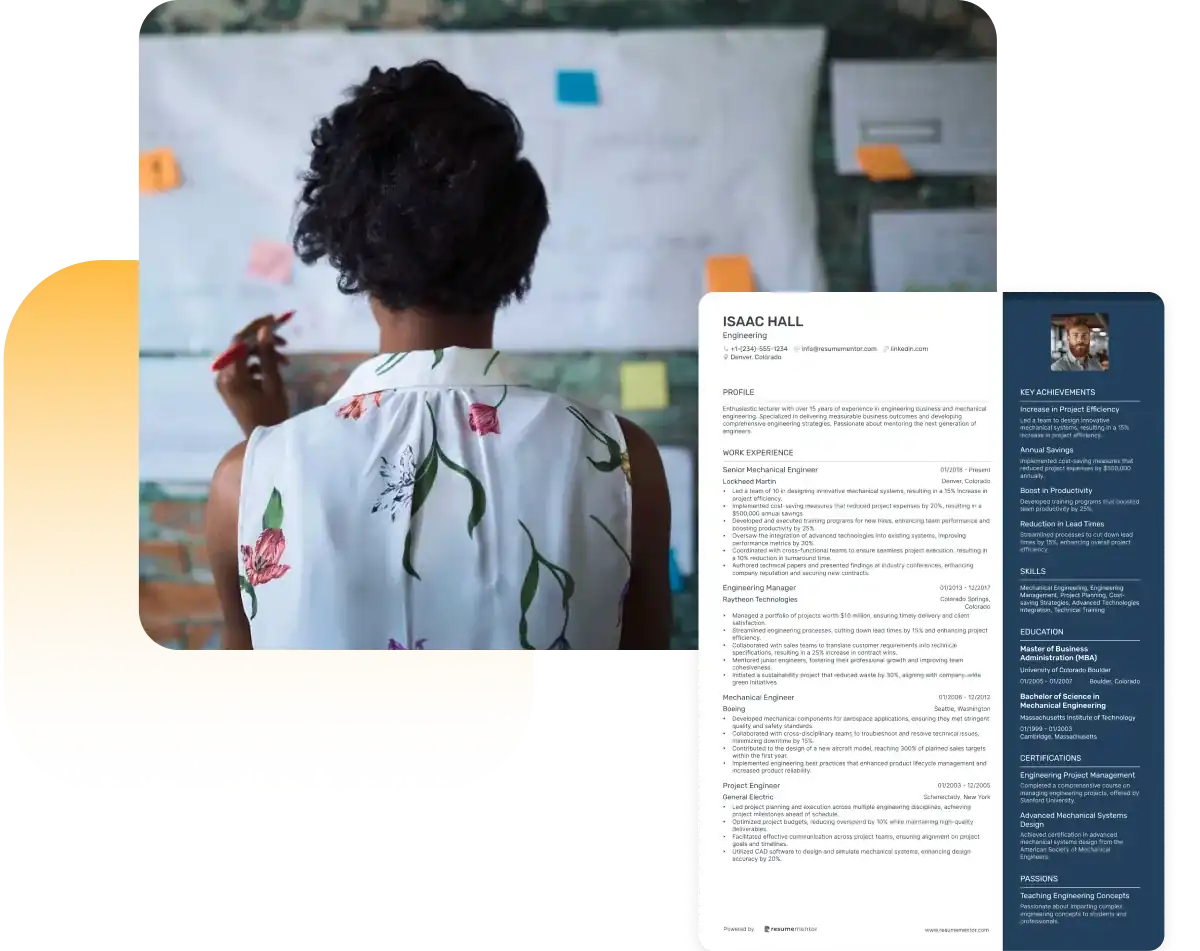
Continue Reading
Check more recommended readings to get the job of your dreams.
Resume
Resources
Tools
© 2025. All rights reserved.
Made with love by people who care.

